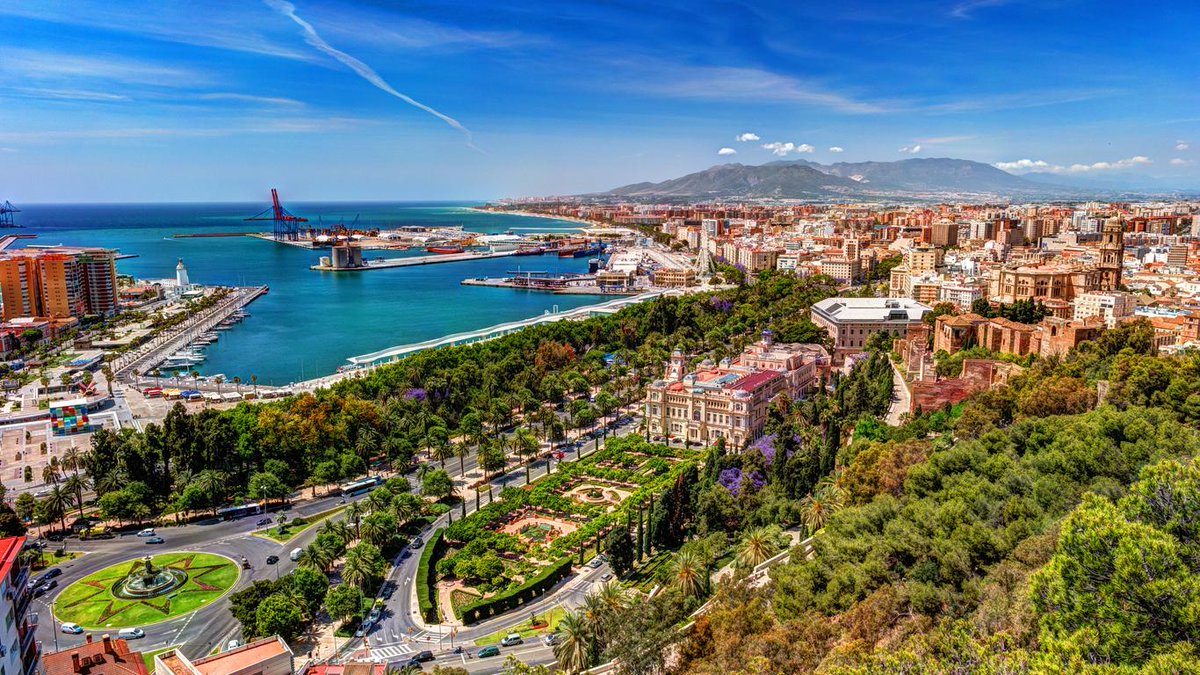Spanish ham is mindblowing.
If you haven't tried it — well, I feel bad for you.
Here's all you need to know about Spain's most popular culinary delicacy:
(a 🧵)




If you haven't tried it — well, I feel bad for you.
Here's all you need to know about Spain's most popular culinary delicacy:
(a 🧵)




Spanish ham is a masterpiece.
To such an extent the average Spaniard eats 7 pounds of ham per year.
There's even a festival dedicated entirely to ham in the Andalusian town of Aracena every October.
📸Expansión
To such an extent the average Spaniard eats 7 pounds of ham per year.
There's even a festival dedicated entirely to ham in the Andalusian town of Aracena every October.
📸Expansión

Needless to say, the enterprise has a lot to show for it.
So let's dive in.
So let's dive in.
First, it's important to understand how they prepare the ham. It's cured — not cooked — which requires them to:
- Take the leg of a pig
- Trim and clean it
- Store it in salt for around two weeks to dry it out
- Leave it hanging to cure
📸 ZS
- Take the leg of a pig
- Trim and clean it
- Store it in salt for around two weeks to dry it out
- Leave it hanging to cure
📸 ZS

But more important than that general process is the nuance within it.
Not all hams are created equal. In fact, the world record for the highest price paid for a single leg of Spanish ham is...
$13,000.
Not all hams are created equal. In fact, the world record for the highest price paid for a single leg of Spanish ham is...
$13,000.
Lucky for us, that cost is extraordinary. And there are ham legs of various price points depending on:
- The type of pig
- The pig's diet
- The pig's % of Iberian genes
- Curing time
- Source
- Farm quality
... and more.
- The type of pig
- The pig's diet
- The pig's % of Iberian genes
- Curing time
- Source
- Farm quality
... and more.
Let's start with Jamón Serrano (Serrano Ham), the most common ham in Spain:
📸: Chacinas de Salamanca
📸: Chacinas de Salamanca

Serrano Ham makes up 93% of the ham production in Spain.
It comes from Cerdos Blancos (White Pigs), which are pink in reality, but with white/light brown hooves.
It comes from Cerdos Blancos (White Pigs), which are pink in reality, but with white/light brown hooves.
This brings up an important point: the color of the hoof is the quickest way to determine the quality of the ham.
White pigs are farmed in enclosures and fed a grain-based diet.
They live around 8 months, cure for the bare minimum amount of time, and head off for sale no more than 12 months later.
The result: a lower quality — although still delicious — cured ham.
They live around 8 months, cure for the bare minimum amount of time, and head off for sale no more than 12 months later.
The result: a lower quality — although still delicious — cured ham.
Unlike with its higher-quality counterpart, the fat in Serrano Ham isn't infused as much with the meat.
Instead, it exists alongside the meat, with little marbling and a content of around 25%.
📸: Spain Recipes
Instead, it exists alongside the meat, with little marbling and a content of around 25%.
📸: Spain Recipes

Nonetheless, there are different categories of Serrano Ham.
The Consorcio Serrano is a group of ham regulators responsible for upholding its quality.
There are both hams with and without this group's production guarantee.
The Consorcio Serrano is a group of ham regulators responsible for upholding its quality.
There are both hams with and without this group's production guarantee.
Requirements for the guarantee:
- Farm quality
- Pigs sourced from Spain
- Farms operating in Spain
- 12-month minimum curing time
- Farm quality
- Pigs sourced from Spain
- Farms operating in Spain
- 12-month minimum curing time
No guarantee:
- Farms not scrutinized for quality
- Pigs sourced from anywhere in the world
- Farms operating in the European Union
- 7-month minimum curing time
- Farms not scrutinized for quality
- Pigs sourced from anywhere in the world
- Farms operating in the European Union
- 7-month minimum curing time
In addition to the Consorcio Serrano guarantee are 3 subcategories based on curing times:
- De Bodega: 1-12 months
- Reserva: 12-15 months
- Gran Reserva: longer than 15 months
- De Bodega: 1-12 months
- Reserva: 12-15 months
- Gran Reserva: longer than 15 months
Serrano ham can be enjoyed by itself, but is also incorporated into other dishes such as Serrano Ham sandwiches seen across the country.
📸: Bon Viveur
📸: Bon Viveur

Popular distributors of Serrano Ham include:
- Jamón de Teruel
- Jamón de Trévelez
- Jamón de Serón
- Jamón de Teruel
- Jamón de Trévelez
- Jamón de Serón
Although it constitutes only 7% of the production, Iberian ham is as good as it gets.
A common price for a leg of Iberian Ham is over 100 euros. The more expensive stuff? 1000.
Jamón Ibérico de Bellota can even get up to 4500 euros per leg.
A common price for a leg of Iberian Ham is over 100 euros. The more expensive stuff? 1000.
Jamón Ibérico de Bellota can even get up to 4500 euros per leg.
So what decides the expense? For one, it comes down to the pig.
Iberian Ham doesn't come from Cerdos Blancos (White Pigs) but instead from Cerdos Ibéricos (Iberian Pigs).
These pigs have dark hair, long ears, long snouts, and iconic black hooves.
📸: Enrique Tomás
These pigs have dark hair, long ears, long snouts, and iconic black hooves.
📸: Enrique Tomás

As mentioned before, a good way to tell the quality of a ham is by the color of its hoof.
If you see black — well, that's the good stuff.
If you see black — well, that's the good stuff.
Most locals call Iberian ham Pata Negra — "Black Leg" Ham.
These pigs come from southern Spain and Portugal, and produce the most delicious ham known to man.
These pigs come from southern Spain and Portugal, and produce the most delicious ham known to man.
But there's more to it than the kind of pig.
What's also important is its way of life.
What's also important is its way of life.
When an Iberian pig reaches 100 kilos they wander around farms called Dehesas.
These consist of olive trees, acorn trees, and chestnut trees, in addition to various herbs, grass, and brush.
The land feeds the pigs; the pigs fertilize the land.
📸: AGFORWARD
These consist of olive trees, acorn trees, and chestnut trees, in addition to various herbs, grass, and brush.
The land feeds the pigs; the pigs fertilize the land.
📸: AGFORWARD

The primary source of food for these pigs comes from the bellotas (acorns).
During Fall & Winter, the pigs wander around eating up to 20 pounds of acorns per day.
As a result, you can taste a subtle nutty flavor in Iberian Ham.
📸: Iberico Club
During Fall & Winter, the pigs wander around eating up to 20 pounds of acorns per day.
As a result, you can taste a subtle nutty flavor in Iberian Ham.
📸: Iberico Club

But not all Iberian Ham is produced like this.
So how do you tell the great from the good?
So how do you tell the great from the good?
There are four primary categories for Iberian Ham.
They are based on diet and genetics and can be distinguished by one of four colors:
- Black
- Red
- Green
- White
(Black being the best, white the worst)
They are based on diet and genetics and can be distinguished by one of four colors:
- Black
- Red
- Green
- White
(Black being the best, white the worst)
Jamón Ibérico de Bellota
- The good stuff; the best ham in Spain
- Black and Red tags
- Pigs eat acorns on a Dehesa during Fall & Winter
- Black tag: it comes from a full-bred Iberian pig, the best Iberian Ham available
- The good stuff; the best ham in Spain
- Black and Red tags
- Pigs eat acorns on a Dehesa during Fall & Winter
- Black tag: it comes from a full-bred Iberian pig, the best Iberian Ham available
Jamón Ibérico de Bellota (continued):
- Red tag: the pig has at least 50% Iberian genes, but is otherwise cross-bred with the Duroc pig
- Cured for 3-5 years
- Red tag: the pig has at least 50% Iberian genes, but is otherwise cross-bred with the Duroc pig
- Cured for 3-5 years
Jamón Ibérico de Cebo de Campo:
- Free-range pigs with at least 50% Iberian blood.
- Acorns don't make up enough of their entire diet
- Also fed cereal-based pig feed
- Green tag
- Cured for at least 3 years
- Free-range pigs with at least 50% Iberian blood.
- Acorns don't make up enough of their entire diet
- Also fed cereal-based pig feed
- Green tag
- Cured for at least 3 years
Jamón Ibérico de Cebo:
- A diet of grain and cereals (Cebo),
- Little to no acorns
- At least 50% Iberian blood
- Don't roam freely
- Makes up 2/3 of Iberian Ham production
- Cured for at least two years
- White flag
- A diet of grain and cereals (Cebo),
- Little to no acorns
- At least 50% Iberian blood
- Don't roam freely
- Makes up 2/3 of Iberian Ham production
- Cured for at least two years
- White flag
Iberian Ham is a part of the EU's Protected Designations of Origen.
This upholds the heritage and quality of the food.
This upholds the heritage and quality of the food.
Additionally, the quality of the land and Dehesa that the pigs are raised on is important.
Therefore, there are four protected geographical locations for acorn-fed Iberian Ham:
Therefore, there are four protected geographical locations for acorn-fed Iberian Ham:
DOP Jabugo: Andalusia, near Sevilla and Huelva
DOP Dehesa de Extremadura: Extremadura, near Cáceres and Badajoz
DOP Los Pedroches: Andalusia, near Córdoba
DOP Guijuelo: Extremadura, Castilla y León, Castilla-La Mancha, Andalusia
📸: Dehesa de Extremadura
DOP Dehesa de Extremadura: Extremadura, near Cáceres and Badajoz
DOP Los Pedroches: Andalusia, near Córdoba
DOP Guijuelo: Extremadura, Castilla y León, Castilla-La Mancha, Andalusia
📸: Dehesa de Extremadura

Unlike with Serrano Ham, it is frowned upon to eat Iberian Ham any way apart from by itself, thinly sliced, by hand.
Of course, that doesn't mean you can't enjoy it with a glass of red wine or sherry.
📸: Basco Fine Foods
Of course, that doesn't mean you can't enjoy it with a glass of red wine or sherry.
📸: Basco Fine Foods

• • •
Missing some Tweet in this thread? You can try to
force a refresh

 Read on Twitter
Read on Twitter









































